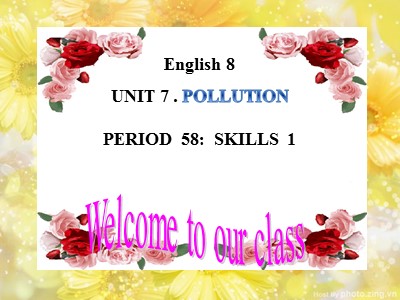Bài giảng Tiếng anh Lớp 8 - Unit 7, Lesson 5: Skills 1 - Trần Kim Phương

2. Mi and Nick have decided to give a presentation on water pollution to the class. Read what they have prepared and answer the questions.
Water pollution is the contamination of bodies of water such as lakes, rivers, oceans and groundwater (the water beneath the Earth’s surface). It is one of the most serious types of pollution.
Water pollution can have many different causes. Factories dump industrial waste into lakes and rivers. Sewage from households is another cause. Farms using pesticides to kill insects and herbicides to kill weeds can also lead to water pollution. These factors cause ‘point source’ pollution while pollutants from storm water and the atmosphere result in ‘non-point source’ pollution.
Water pollution can have dramatic effects. In many poor nations, there are frequent outbreaks of cholera and other diseases because of people drinking untreated water. Humans can even die if they drink contaminated water. Polluted water also causes the death of aquatic animals such as fishes, crabs, or birds. Other animals eat these dead animals and may also get sick. In addition, herbicides in water can kill aquatic plants and cause further damage to the environment.
So what should we do to reduce water pollution?
English 8UNIT 7 . POLLUTIONPERIOD 58: SKILLS 1Welcome to our classA. READING. - sewage (n): nước thải sống, nước cống - household (n): hộ gia đình - pesticide (n): thuốc trừ sâu - herbicide (n): thuốc diệt cỏ - factor (n): nhân tố - dramatic (adj): kịch tính, sâu sắc- outbreak (n): sự phun ra, sự bùng phát- cholera (n): bệnh tả - untreated (adj): không xử lý I. VOCABULARY:II. Reading:1. Work in pair. One of you looks at picture A, and the other looks at picture B on page 15, Ask each other questions to find out the differences between your picturesPICTURE APICTURE BThe ducks are whiteThe ducks are blackThey’re going to the lakeThey’re going from the lakeThere aren’t any factories near the lakeThere are some factories near the lakeThe lake water is cleanThe lake water is dirtyII. READING2. Mi and Nick have decided to give a presentation on water pollution to the class. Read what they have prepared and answer the questions. Water pollution is the contamination of bodies of water such as lakes, rivers, oceans and groundwater (the water beneath the Earth’s surface). It is one of the most serious types of pollution. Water pollution can have many different causes. Factories dump industrial waste into lakes and rivers. Sewage from households is another cause. Farms using pesticides to kill insects and herbicides to kill weeds can also lead to water pollution. These factors cause ‘point source’ pollution while pollutants from storm water and the atmosphere result in ‘non-point source’ pollution. Water pollution can have dramatic effects. In many poor nations, there are frequent outbreaks of cholera and other diseases because of people drinking untreated water. Humans can even die if they drink contaminated water. Polluted water also causes the death of aquatic animals such as fishes, crabs, or birds. Other animals eat these dead animals and may also get sick. In addition, herbicides in water can kill aquatic plants and cause further damage to the environment. So what should we do to reduce water pollution?* Answer the questions: 1. What does the second paragraph tell you about? 2. What does the third paragraph tell you about? 3. What is groundwater? 4. What are point source pollutants? 5. What are non-point source pollutants? 6. Why do people use herbicides? The second paragrah tells us about the causes of water pollution.The third paragraph tells about the effects of water pollution. It’s the water beneath the earth’s surface. They are industrial waste, sewage, pesticides and herbicides. They are pollutants from storm water and the atmostphere.They use herbicides to kill weeds.3. Read the text again and complete the notes about the effects of water pollution. Fill each blank with no more than three words.If the drinking water is untreated, an outbreak of may happen.2. People drinking contaminated water may 3. Fish, crabs or birds, may also die because of 4. Other animals may become ill if they eat the ..... animals.5. Herbicides kill both weeds and ...choleradiepolluted waterdeadaquatic plants4. Work in groups and discuss the solutions to water pollution. Make notes of your answers.Give heavy fines to companies that are found doing this.2. Educate companies about the environment.3. Give tax breaks to companies that find “clean” ways to dispose of their waste.B. SPEAKING. 5. Now complete the diagram of water pollution. Use the information from the text for the causes and effects and your group’s ideas for the solutions.Water pollutionThe contamination of bodies of water such as lakes, oceans and groundwater.CausePoint source pollutants: industrial waste, sewage, pesticides, herbicides.- non-point pollutants: pollutants from storm water and atmosphere.EffectHuman: die if they drink contaminated water.Animals: die - plants: killed.Sollution- Give heavy fines to companies that are found doing this.6. Make a presentation about water pollution based on the diagram.IV. Homework:Learn by heart the vocabulary.Do the exercises D1,2- 7 (Workbook) C2,3- 7 (Exercise notebook)Prepare: Unit 7 (Skills 2)
Tài liệu đính kèm:
 bai_giang_tieng_anh_lop_8_unit_7_lesson_5_skills_1_tran_kim.pptx
bai_giang_tieng_anh_lop_8_unit_7_lesson_5_skills_1_tran_kim.pptx



